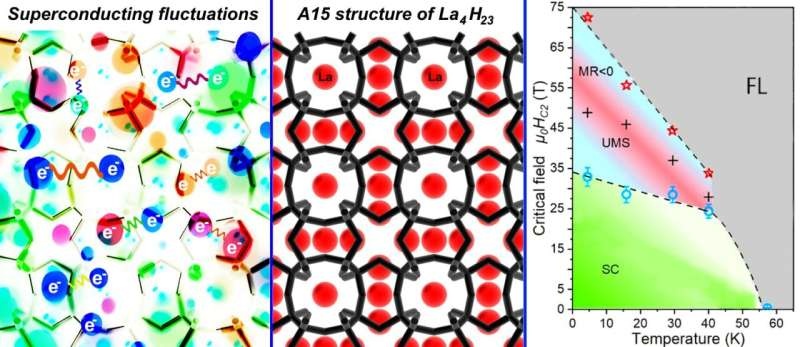Researchers have discovered a new type of hydrogen-rich superconductor, La4H23, that exhibits some unusual properties, including a negative temperature coefficient of electrical resistance and unexpected behavior in strong magnetic fields. This finding could lead to a better understanding of the complex nature of these materials and their potential applications.

The Elusive Superhydride
At extremely high pressures, scientists have created a new class of compounds called polyhydrides that are largely responsible for these record-breaking superconductors. These materials can have critical temperatures up to −23 °C; critical magnetic fields up to around 300 teslas; and current densities that are about 10 times those of the best commercial HTS wire.
One particular example is the newest member of the A15-type lanthanum super hydrides: La4H23. Rather than have their electric resistance decrease with lower temperatures as is typical of regular metals, this material exhibits an anomalous negative temperature coefficient — when the temperature goes down, its resistance increases. If any material exhibits this behavior more commonly it is semiconductors and unconventional superconductors, like cuprates.
Revealing the Odd Metal State
La4H23 also surprised the researchers in high magnetic field actions. In general, the application of a magnetic field significantly broadens superconducting transitions in materials because it introduces inhomogeneities within the superconductor by creating vortices where Cooper pairs are depleted. This broadening behavior is rarely seen in polyhydrides, as the magnetic vortices, called Abrikosov vortices, are rather tightly pinned to existing structural inhomogeneities.
In the case of the new lanthanum superhydride, something even more spectacular happened: superconducting transitions sharpened in a high magnetic field up to 68 tesla. The team explored further and found an anomalous metallic state with large negative magnetoresistance (Yes it’s weird!) Negative magnetoresistance is a distinctive effect characteristic of unconventional superconductors (also other metals in the strange metal phase) with significant, though non-bulk, BCS-like superconducting fluctuations.
Conclusion
The identification of novel La4H23 with its extraordinary characteristics presents a major opportunity to explore the mysterious physics behind these complex systems. The observation of an exotic metallic state in strong magnetic fields, and the manifestation of negative temperature coefficient (NTC) of electrical resistance may suggest that these polyhydrides can be explorers between conventional superconductors (CS) and unconventional ones. More investigation along these lines might help elucidate how the electron transport takes place in this type of materials and, perhaps, set the stage for other applications in unconventional superconductivity.
